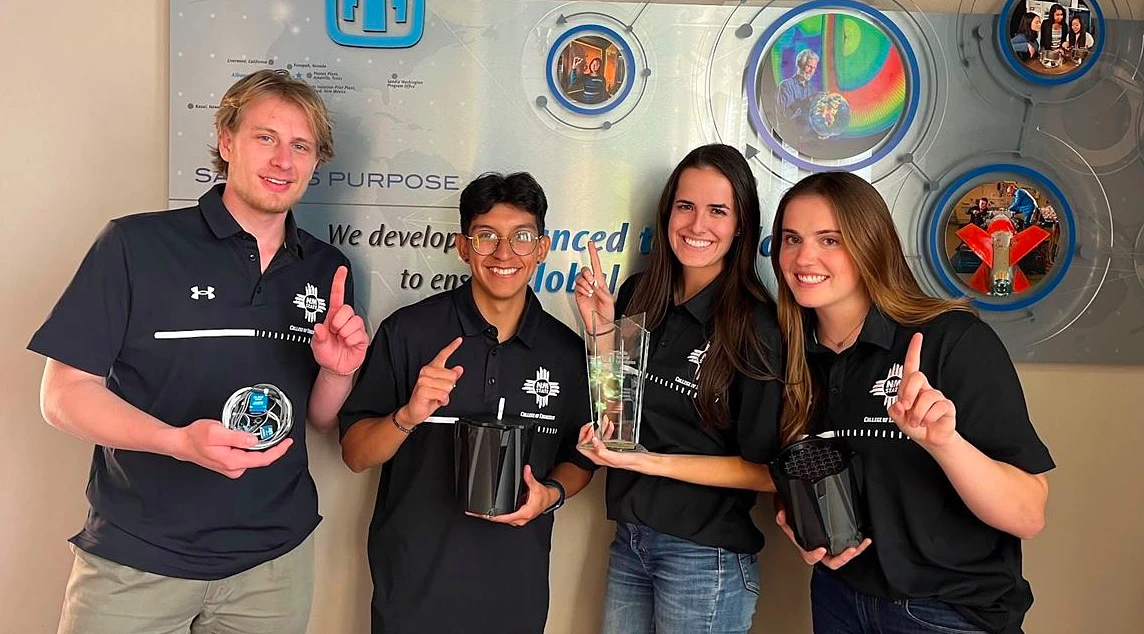This spring, one New Mexico State University engineering student group garnered more than an A in the culminating course for degree completion. They earned a first-place award in the New Mexico Capstone Challenge IV sponsored by Sandia National Laboratories, a competition among NMSU, New Mexico Tech and the University of New Mexico. It is the second year in a row that NMSU students have won this award.
“All engineering students complete their degree programs by participating in a collaborative year-long, hands-on, interdisciplinary team project that gives them an opportunity to apply the engineering skills they have studied,” Assistant Dean of Student Success Gabe Garcia said. “To make the course even more valuable to our graduates, we’ve been working with industry sponsors for our capstone courses; this year some 30 plus sponsors participated. This gives students exposure to the environment they will experience when they become professional engineers.”
Electrical engineering students Carson Anderson and Eduardo Quispe-Olaya, along with mechanical and aerospace engineering students Tori Hoffman and Hannah Linder comprised the NMSU team for the project “Operation Humpty Falls Again.”
Two Sandians were assigned to mentor the students: Bo Mulligan and Anne Grillet, both senior members of the technical staff.
“For this project, the students had to protect a fragile glass Christmas ornament through a series of thermomechanical environments, a similar task that engineers at Sandia worry about every day. The capstone competition provides a great opportunity to work in a team to solve challenging problems similar to practicing engineers. They also get exposed to both experimental and computational tools that would normally be reserved for graduate level students,” Grillet said.
“A key element of this year’s challenge was that the protective cradle needed to be printed using additive manufacturing, a technology that Sandia is still figuring out how to best utilize. In this year’s design, the NMSU team used fiber reinforced polymers to improve the strength and toughness of the materials. Of course, protecting delicate payloads from harsh and varied mechanical environments is something that Sandia is very concerned about. You can make a direct comparison from the cradle the teams worked on to the Mobile Guardian Transporter that Sandia has been developing,” Mulligan said.
Under the tutelage of Mechanical and Aerospace Engineering Associate Professor Abdessattar Abdelkefi, the students began working on the two-semester this past fall. The students used a bottoms-up systems engineering approach to the project. This entailed analyzing Humpty’s failure mechanisms, modeling how and where to protect Humpty, choosing the best materials to meet testing requirements and manufacturing and testing the cradle.
“This was one of the most hands-on projects I’ve done,” said Hoffman, team project manager. “I learned so much about building, testing and prototyping by applying my skills in an actual project.”
Hoffman said the team members worked very well together, which is not always the outcome in assigned teams.
Hoffman and Linder tackled the mechanical and structural design. Linder conducted the design verification and validation analysis. Hoffman conducted the math analysis. Anderson and Linder performed the 3D printing of the cradle components, while Anderson and Quispe-Olaya designed the data electronic acquisition systems.
“The design parameters were the biggest challenge,” Hoffman said. “Sandia’s outline was not very definitive about the parameters. We pushed the test limitations to the limit. For the outer layer we used onyx-Kevlar which is rigid. We compressed our cradle up to just below 18,000 pounds. For the middle layer, they selected a thermal plastic called ULTEM-95 which has a high thermal diffusion. For the inner layer, we used TPU, a thermoplastic polyurethane lattice structure that is a squishy substance and could take the impact.”
“Our multidisciplinary team of students was collaborative and patient. They studied the different aspects of the system from design, manufacturing and testing. The students were so motivated and tried to get the right information from Sandia staff members and they tried to be efficient in terms of time and accuracy of their design and testing,” Abdelkefi said. “I was lucky to have this great team of students.”
The two-day competition held at Sandia National Laboratories and Kirtland Airforce Base in Albuquerque was a close contest. NMSU’s score was only one point higher than UNM’s.
“It was cool to see how different the designs were and how they held up,” Hoffman said.
“From day one, this team has been very focused and independent. Each student was responsible for a different part of the design and they worked very well together. Tori Hoffman did a great job keeping the team organized and implementing the systems engineering approach. Hannah must have learned four different modeling tools to get the necessary numerical predictions to design the protective cradle. Dawson and Eduardo took care of the electronics and sensor packages,” Grillet said.
“Overall, their use of CAD modeling, simulation, lattice generation and additive manufacturing tools available to them was impressive. Particularly impressive was their use of a flexible TPU lattice, fabricated using SLS additive manufacturing, to help cushion the ornament during environmental testing,” Mulligan said.
Three of the students, now graduated, have big plans. Hoffman will become a propulsion engineer for Virgin Galactic, Linder will work at Cummins, Inc., and Quispe-Olaya plans to pursue a graduate degree and work at White Sands Missile Range. Anderson, who has one more semester to go, also plans to attend graduate school and work for Honeywell FM&T.
Skip past news feed


